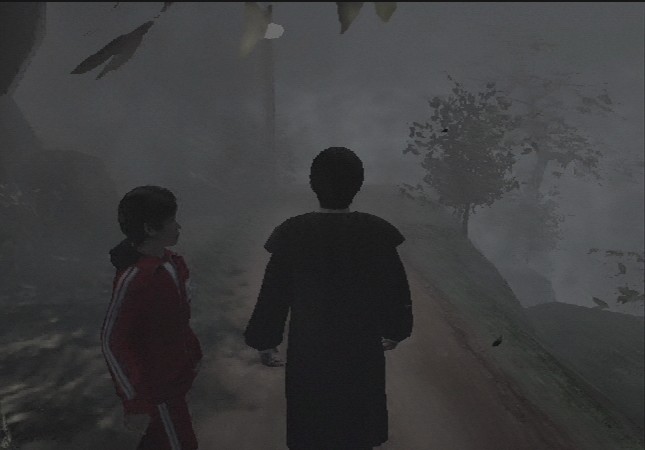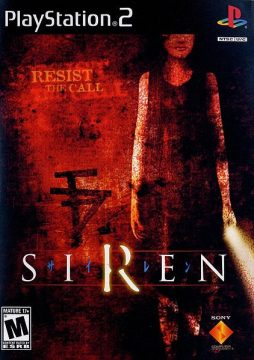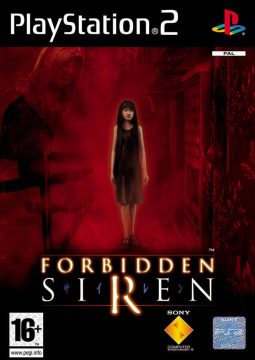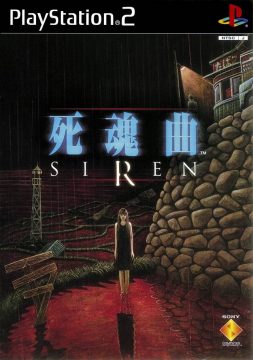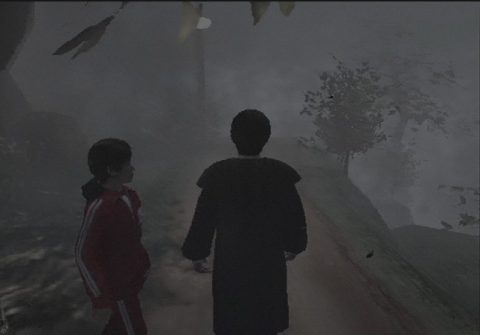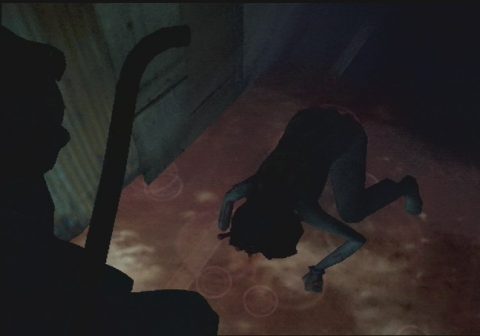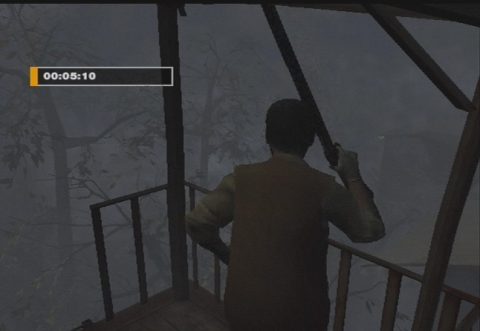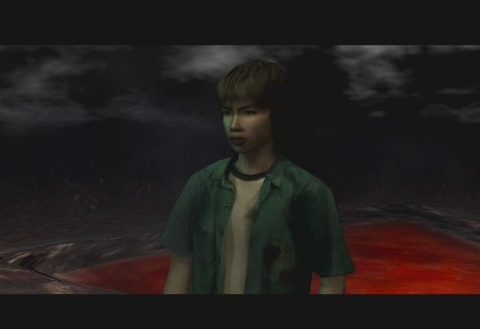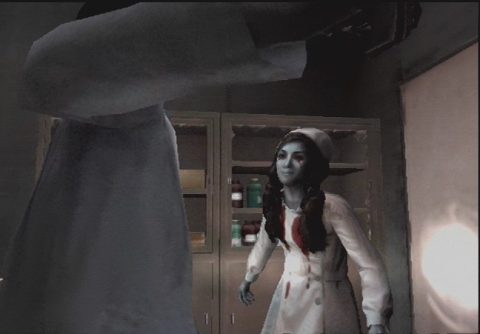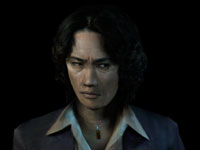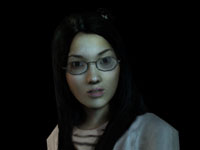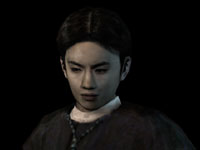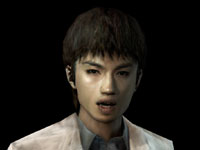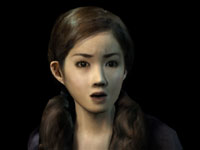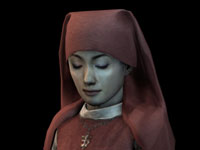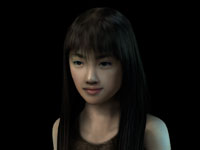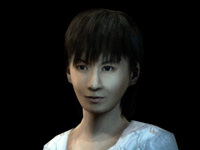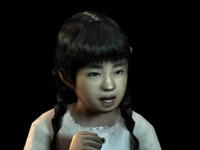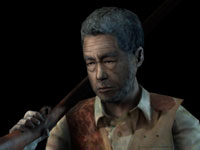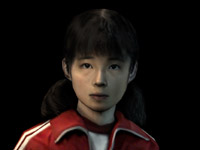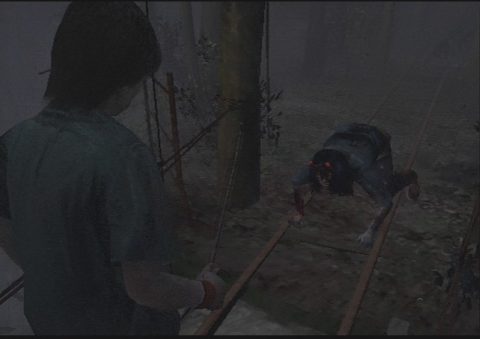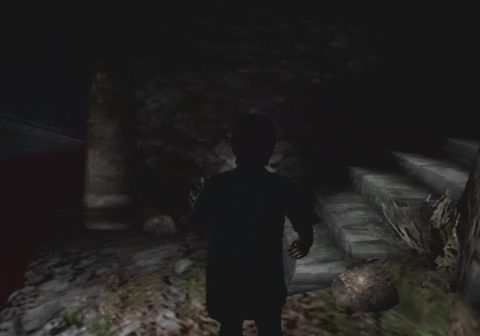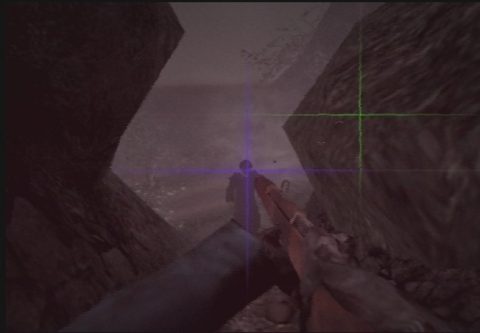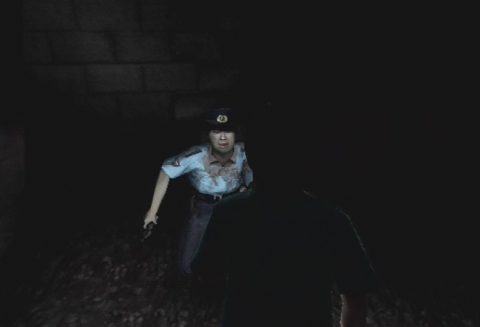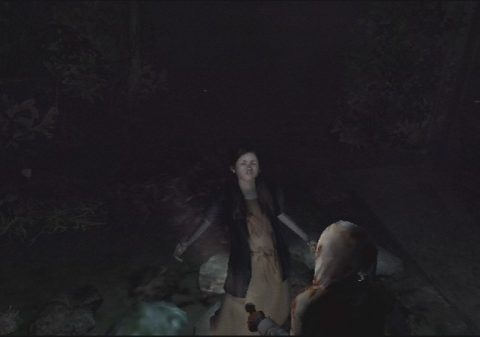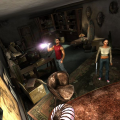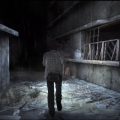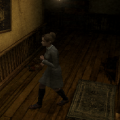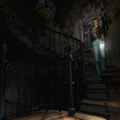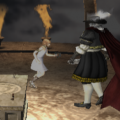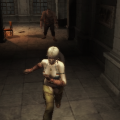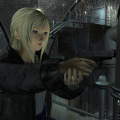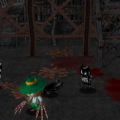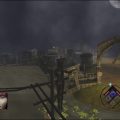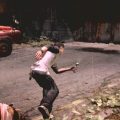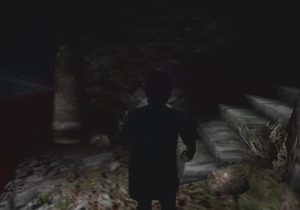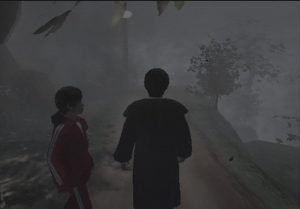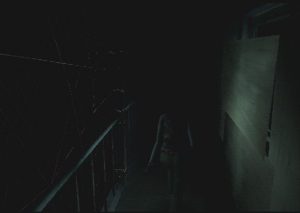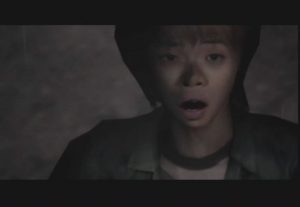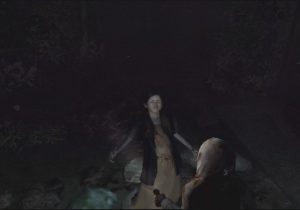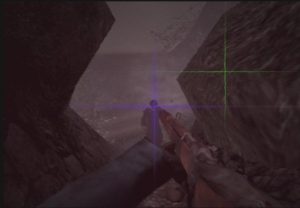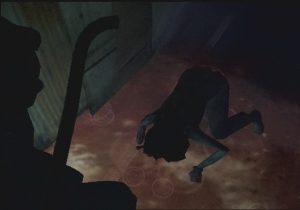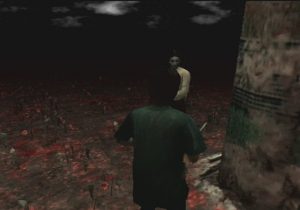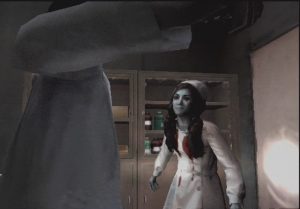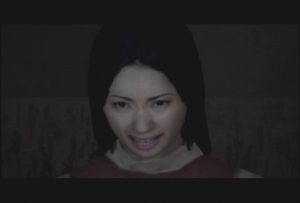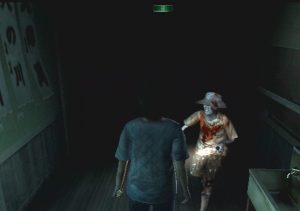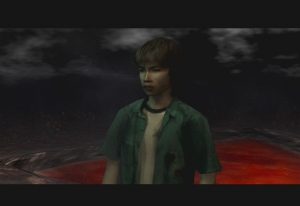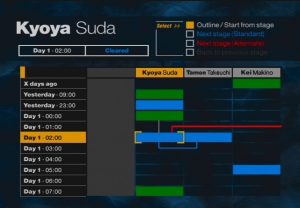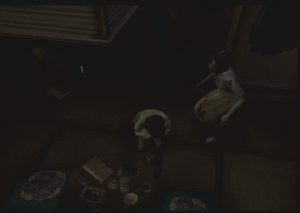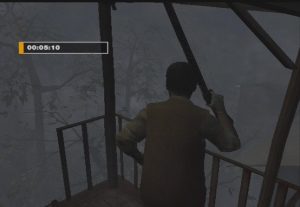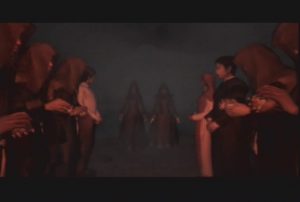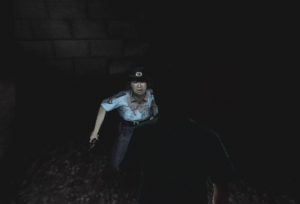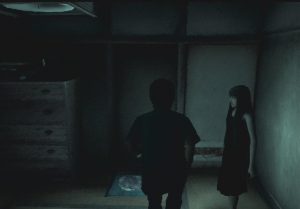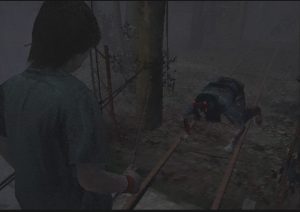People enjoy being scared. Horror films are a staple of late night television and high school dates, both situations where a shiver down the spine is a welcome and delicious sensation. Authors such as Stephen King, Clive Barker, and Peter Straub have built their careers on telling frightening tales, and have sold untold millions of books. The Twilight Zone, with its unsettling morality plays and often unhappy endings, is a cultural touchstone and has inspired countless imitators and homages. Even static media such as paintings and sculpture can be used to communicate terror and unease: Hieronymous Bosch’s skill in depicting the torments of the Christian Hell in his paintings is legendary, and the illustrations of Stephen Gammell have been giving children nightmares for nearly twenty-five years.
Video games have also tried to communicate feelings of dread, tension and fear to the people who play them, but the results have been mixed at best. Part of the problem is that video games are traditionally designed in such a way as to empower the player: games are supposed to be beaten, after all. Removing that empowerment through such genre conventions as intentionally poor controls, overwhelming numbers of enemies, or limited weapons and ammunition oftentimes leads not to fear, but frustration. Likewise, tedious and illogical puzzles, fetch quests, and obtuse goals can potentially ruin the horror experience for a player. It’s a delicate balance for the designer of a survival horror game. No other genre has such a tight rope to walk.
So: how do you empower a player, but retain the ability to scare him? How do you walk that tight rope with confidence and keep the player interested and progressing through the puzzles, enemies, and all too frequent deaths? That was the question that the members of Team Silent at Konami asked themselves in 1998, and the answer they delivered was Silent Hill for the PlayStation. The game is considered a classic, and with good reason: it’s scary, atmospheric, successfully blends traditional western horror film techniques with the subtle and understated psychological tones that define Japanese horror. It was both popularly and critically acclaimed, and led to the game becoming a revered and successful franchise. It’s widely considered a pillar of the survival horror genre.
Team Silent produced three more Silent Hill titles over the next five years and went their separate ways. Some remained at Konami to work on other projects. One member, Akira Yamaoka, remains involved with all things related to the Silent Hill license to this day, acting as producer and composer for the two games produced by outside developers for Konami. A few former members of Team Silent, however, decided that they weren’t done frightening people yet. After parting ways with Konami, they set up shop at Sony’s Japan Studio and began work on a game that would continue the terrifying legacy of the Silent Hill franchise. They had an evolution in mind, one that would take the basic structure of Silent Hill and turn it on its head. They set out to redefine Survival Horror yet again. The resulting game was Siren.
Siren is the brainchild of Keiichiro Toyama and Naoko Sato, who together wrote the scenario, and Isao Takahashi, who filled the role of art director. Keiichiro Toyama was the creator and director of the original Silent Hill (though he was not involved with any of the sequels that followed), and has directed the entire Siren series to date. Naoko Sato was the monster designer for Silent Hill (along with Masahiro Ito, who did not work on Siren) and was also co-motion and “story demo” designer. Isao Takahashi was a background designer for Silent Hill. Since the two series have the same creators in such important positions, there are obvious parallels between the two, although the similarities are often only skin deep.
Siren is a bold and challenging series that raises the bar for the entire survival horror genre. There is nothing else like it, and if you can learn the rules the game demands you obey, Siren will make you rethink how horror games can take the player to an uncomfortable, terrifying, and ultimately fascinating world where things are never quite what they seem.
In the quiet, isolated town of Hanuda in rural Japan, location of an infamous mass murder, a terrible ritual is interrupted, just as the town is devastated by an earthquake. When the ground settles, the town finds itself isolated from the rest of the world, surrounded by an endless ocean of red water. Even worse, most of the inhabitants of the village are transformed into terrifying undead creatures called “Shibito” (rendered in kanji, it literally means “dead person”), who are anything but “dead”. You play through three days in the shoes of ten different playable characters (who are sometimes accompanied by a few important NPCs), all attempting to survive the chaos and terror that follows the aftermath of the earthquake. Every character you encounter during the course of the game, playable or not, are slowly turning into Shibito themselves, which allows for some truly disturbing moments and a few excellent genre-defying mechanics. During your stay in Hanuda village, you’ll discover the terrible secrets of a town that has literally sold its soul to things best left forgotten, and learn just how far some people will go to survive.
The characters that the player controls and interacts with during the three-day nightmare that consumes the village are interesting. They often have little in common with each other but a desire to live through the deathtrap that Hanuda village has become: these characters are not united in the face of danger. Siren has a central plot, but not every character is directly related to it. Despite this, each character and their story are fully fleshed out and complete in and of themselves, which adds a note of gravity to the overall narrative.
Siren employs a story and game mechanic called the “link system” to tell the tale of Hanuda village. Each chapter, when completed, adds a bit more to the players?understanding of the various sub-plots, and how they relate to the overarching narrative, through items and documents that are viewable in the link navigator section of the menu. These items and documents are placed in chronological order and not in the order in which they are discovered, which makes it difficult to determine whether or not the player has missed something until late in the game.
Even though some characters never meet or cross paths, actions that the player takes in some chapters will affect later chapters of the game. This is achieved through the completion of secondary objectives, which open up alternate routes and scenarios for subsequent chapters. These secondary objectives don’t affect the story, but provide options for navigation and items that somewhat eases later chapters for the player.
Siren has a diverse and surprisingly well-realized cast of characters. It has more in common with a novel or movie than a traditional game. There are no super soldiers or super cops: instead, you have a professor, a doctor, and a schoolteacher, among others. Since the background for each character is carefully explored through items and cut scenes, the reality of trying to sneak through a town full of ravenous undead as, say, a blind ten-year-old really hits home. No cavalry is coming to rescue them. These people, regular citizens, must somehow survive on their own. Some characters will live, some will die, and some will emerge from the disaster irrevocably changed.
Characters
Kyoya Suda
If Siren can be said to have a hero character, then Kyoya is it. A lover of urban legends, the teenager travels to Hanuda in order to dig up dirt on a massacre rumored to have occurred many years ago. He finds a lot more than he bargained for.
Tamon Takeuchi
Professor Takeuchi was born in Hanuda. He lost his parents as a child in strange circumstances, and returns to the village to discover the truth of what happened so many years ago. Takeuchi starts the game with a gun, which is very useful.
Yoriko Anno
Yoriko is a student of Professor Takeuchi, and harbors a secret crush on him. She shows a lot of personal strength by the end of the game.
Kei Makino
This shady character is a resident of Hanuda, and is a priest of the local religion. He is the twin brother of Shiro Miyata. His eventual fate is less than clear, but clever players will figure it out.
Shiro Miyata
The twin of Kei Makino, and an even shadier character. Shiro is a doctor, and harbors a secret nearly as dark as the curse that engulfs Hanuda.
Risa Onda
Risa was visiting her twin sister Mina when Hanuda undergoes its transformation. She’s probably the least helpful and capable character in the entire cast. Mina is Risa’s twin sister, and works at the local hospital as a nurse. She is not playable, and acts as the games?Pyramid Head character. Her physical form is bizarre, and she is the most dangerous and powerful Shibito the player will encounter.
Hisako Yao
A mysterious young woman of unknown purpose. She seems to be suffering from memory loss, and assists Kyoya early in the game.
Miyako Kajiro
A fourteen-year-old girl of unusual inner strength and demeanor. She is heavily involved somehow with the terrible goings on at Hanuda village. She is blind, and can only see by sight-jacking.
Reiko Takato
A local school teacher. Reiko is stargazing with a student when the curse descends on Hanuda, and vows to protect her from the horror that engulfs the village at all costs.
Harumi Yomoda
This ten year old is stargazing with her teacher when the red ocean comes to the village, and depends on her teacher to help her survive. She’s possessed of ESP, and can sight-jack even though she’s never exposed to the red water itself.
Akira Shimura
An elderly hermit and skilled hunter, Akira knows quite a bit about the local religion. He lost his wife and son during the earthquake of 1976, which still grieves him. Akira carries a rifle.
Naoko Mihama
The pompous and narcissistic host of a cable TV show called Occult Japan. Her character is incredibly annoying, and her ending is extremely satisfying.
Siren (called Forbidden Siren in Europe) plays out in short chapters, each of which put you in control of a single survivor, though other survivors may be present. Siren has a subtlety in its story that other games in the genre lack; much like the fan-favorite Silent Hill 2, it relies on the intelligence and astuteness of its audience to pick up on threads and hints and encourages the player to figure things out for themselves. On top of the non-linear timeline, much of the story is acquired through items and notes littered throughout the environment, similar to Resident Evil and Silent Hill. A letter from a villager to a local doctor found on a desk in an office the player is hiding in might shed some light on the overall narrative of the prior chapter for example. Of course, if a player isn’t paying careful attention, he could miss some of these items and end up without a clear idea of what’s happening until the endgame, so paying attention to your environment is paramount.
No discussion about Siren should go without mention of its difficulty: Siren is one of the hardest and most nerve-wracking games ever created. The Shibito are smart, very difficult to put down, and sometimes come in numbers. Some of the player characters are physically helpless, and one misstep can mean reloading your save. That being said, the game is usually pretty fair. It rewards patience, smarts, and knowledge of its mechanics better than any other game in the genre. There is no “gaming” or “cheating” the systems that drive Siren: you will play the game correctly, or you will reload your save. It’s unforgiving, but if you learn how to play intelligently, and take advantage of the tools that the game gives you, it can be one of the most satisfying horror gaming experiences you’ll ever have. While Siren is oftentimes extreme in the pressure it puts on the player, it avoids falling off the proverbial tight rope by quickly establishing the rules the player must obey to succeed, and sticking to them religiously. A careful player will never be screwed over by poor controls or unforeseen situations, and since most characters are physically incapable of taking down Shibito, limited ammunition quickly becomes irrelevant. Staying hidden and moving carefully are the weapons a careful Siren player chooses.
If staying hidden and moving carefully are the weapons a player must use to successfully play the game, then sight-jacking is the ammunition. Every playable character in the game can sight-jack, and it’s the single most important mechanic in the game. Think of sight-jacking as a first person rendition of the “vision cone” that the guards in Metal Gear Solid display in Solid Snake’s radar: sight-jacking allows the player to literally see through the eyes of other characters, and more importantly, any Shibito that might be nearby (this is due to the characters’ slow transformation into Shibito themselves. It’s not really all that great of a trade-off, if you think about it). To do this, you need to hold down the trigger button and rotate the analog stick, filtering through the static until you get a clear picture – it’s a bit like tuning a TV antenna. When you elect to sight-jack a nearby character or Shibito, you see through its eyes until you release your sight-jack, or decide to sight-jack someone (or something) else. Your character can’t move while sight-jacking, so it’s important to activate it only when you’re certain that you’re not in danger of being discovered. It’s a clever and innovative mechanic that allows you to learn when, where, and how it’s safe to move towards your goal, and will sometimes allow you to discover routes and items that you would not have been able to find otherwise.
Shibito are the primary enemy a player will encounter in Siren. They are the reanimated (or simply transformed) remains of the citizens of Hanuda who did not survive the events that concluded with the coming of the red water. They litter the entire town and surrounding countryside, either actively searching for the player characters or reenacting normal everyday activities in a terrible mockery of their former lives. They are analogous to a traditional “zombie” but blend the classic characteristics of the walking dead with many of the unsettling quirks that makes the monsters in Silent Hill so disturbing. Strange jerking motions, bizarre noises, and dead eyes are key design elements of Shibito. They come in several different varieties, though most look largely human. Regardless of physical appearance, the player quickly learns that Shibito are not to be trifled with.
Shibito are very difficult to put down, and some are outright invincible. Some characters are tougher or better equipped than others, too: where one character might be able to temporarily overpower a Shibito and make it to safety, another is entirely helpless. That fact simply underlines the importance of sight-jacking as a method of evasion and remaining hidden. All Shibito have a proscribed patrol route that you must learn, which can be very complex. These aren’t the guards in Metal Gear Solid, despite the earlier comparison: sound attracts them far quicker, their patterns are more complicated and less repetitious, and you may not be able to kill them if they see you.
There are no health packs in the game: characters regenerate health over time. Considering the already steep difficulty curve, regenerating health is a blessing. If you’ve been caught and beaten up by a Shibito, you’re still in the game as long as you can escape, hide somewhere safe, and sit still for a minute or so.
Siren employs a flashlight much like Silent Hill, but only suicidal idiots bother to turn it on unless they’re absolutely sure that there are no nearby enemies. Light attracts Shibito very quickly, which we’ve already established is something to avoid. Some characters have access to a gun, which is made more useful with judicious application of the flashlight, but otherwise it seems to be there to get your character killed. Just leave it off. Additionally, a lot of actions require the player to fiddle around in menus: for a game designed to be as tense and frightening as possible, this can quickly become tedious and detract from the tension the game tries to create.
Special mention should be made of the sound design and art direction in Siren. The superficial comparisons to Silent Hill are obvious and irrefutable, but it’s to be expected given that the same key people created both games. The graphics are some of the best on the PS2, and the audio track does an admirable job of keeping the player alert and frightened: especially if you play the game at one in the morning with your lights off and the surround sound system turned up. The cutscenes are intentionally murky, and jerkily animated. The Shibito move in an unnatural and unnerving way, and their shrieks and muttering are both disturbing and discordant. Their design, both visually and aurally, are more than simple shock value: it reinforces the need for stealth on behalf of the player. The only odd spot – the characters look like the developers took photographs of real actors, digitized them, and put them on the models. It all looks a bit unnatural, but it adds to the creepiness. However, since the game was localized in England, all of the characters have British accents, and none of the acting is terribly good.
The levels are intelligently laid out and lack any of the jarring out-of-place fetch quest puzzles that mar games like Silent Hill and Resident Evil. By way of example: you’ll never need a five-sided jewel to open the door on a women’s restroom. Siren focuses on keeping the player drawn into its world, and does it’s best to ensure that the suspension of disbelief is maintained. The game does suffer from “Man, it sure is dark” syndrome, which can sometimes disorient the player and lead to some unnecessary death and frustration, but given how much it adds to the atmosphere, it can be forgiven.
Prior to the release of Siren, Sony launched two viral websites that tie into the game and provide a tiny bit of back story. One, a public forum dedicated to weird science and supernatural investigation called www.occultland.com, references Kyoya’s plans to travel to Hanuda. The second, Urban Folklore, originally contained a single post detailing some rumors and speculation about the origins of the tales of Hanuda village, but has been updated with new information and hints for every new Siren game. These websites are primitive looking, and ultimately light on content, but are interesting examples of viral marketing and make quick and fun reads for fans of the game.
All in all, Siren is an interesting and demanding experience that all lovers of survival horror should play. It’s hard, unforgiving, and requires a lot of patience, but the satisfaction to be gained in mastering its system and finishing the game is worth it to fans of survival horror.
Links:
The Forbidden Siren fan site
Official Siren North American website
Official Siren Japanese website
Chris – Survival Horror Quests – review of the original Siren
Forbidden Siren: The Movie on IMDB
Viral Siren Websites Index:
www.occultland.com
www.shibito.com
www.Shu-Mikami.com
www.yumemi-salon.com
www.hw-biker.blog-paradise.com
